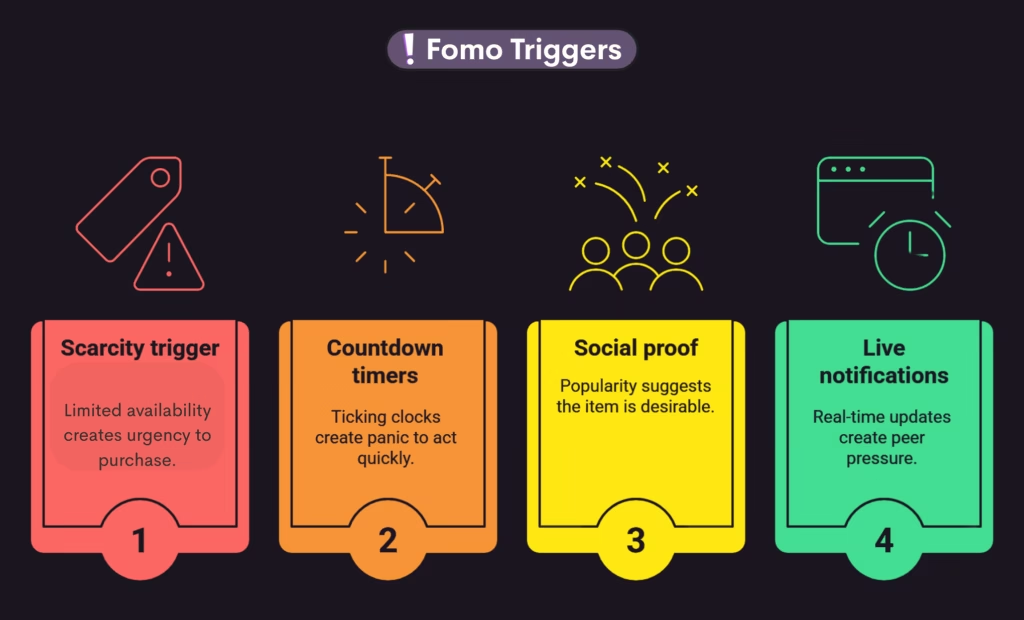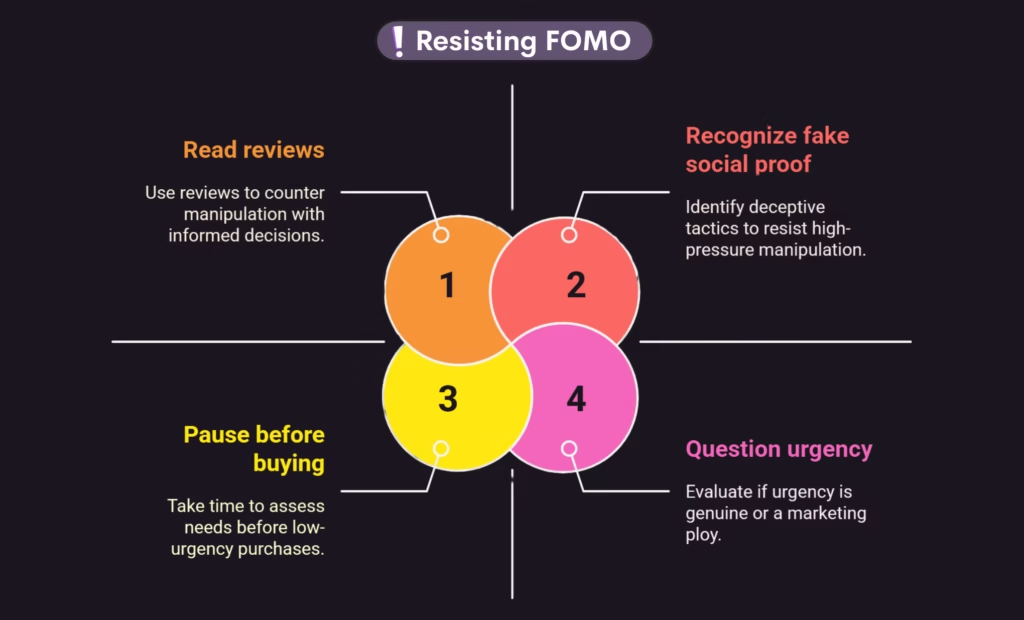Ever felt a sudden urge to buy something just because it was “almost sold out”? Or booked a flight faster than usual because there were “only 2 seats left”? Yup—welcome to the world of FOMO in UX design.
In this article, we’ll learn the FOMO meaning, how it plays with your brain (gently or not so gently), and the smart-but-sneaky UX tactics that use psychological triggers like social proof and scarcity to drive clicks, sales, and sometimes—regret.
What Does “FOMO” Really Mean?
FOMO, short for Fear of Missing Out, is that anxious feeling that something exciting or important is happening without you. Originally a pop-culture term, it’s now a real psychological driver—especially in digital spaces. The FOMO meaning isn’t just about missing out on events—it’s a psychological trigger that influences decision-making, especially in digital environments like e-commerce and social media.
But in UX and marketing?
FOMO isn’t just a feeling—it’s a strategy. Brands, websites, and digital platforms intentionally design experiences that trigger FOMO. And the wild part? It works.
The Psychology Behind FOMO Meaning in UX Design
So why does FOMO mess with our brains?
It all comes down to:
- Loss aversion – We hate losing opportunities more than we love gaining them.
- Urgency and scarcity – When time or options feel limited, we act fast.
- Social comparison – Seeing others buying, joining, or clicking makes us want to do the same.
In psychology, these are known as cognitive biases. UX designers use them to craft interfaces that feel urgent, popular, or exclusive—without actually saying “BUY THIS NOW.”
Breaking Down the FOMO Meaning in Everyday UX
Let’s decode some real-world examples that look innocent… but scream FOMO!
“Only 3 left in stock!”
Classic scarcity trigger. Suddenly, you’re racing to the checkout like it’s the Hunger Games.
Countdown timers
Whether it’s for a sale, webinar, or free shipping—those ticking clocks activate your internal panic switch.
“12 people are viewing this item right now”
HELLO social proof! If others want it, we assume it’s good. We don’t want to be the one who misses out.
“Elena from Paris just bought this”
Live pop-up notifications are basically digital peer pressure dressed up in pastel.

How FOMO Affects Online Shopping Behavior
FOMO has direct effects on online shopping behavior:
- We make quicker decisions (sometimes skipping research).
- We experience higher emotional arousal during the purchase.
- We’re more likely to buy things we don’t really need (hello, 3AM Etsy order).
This is psychology for sale. Brands tap into our brains to convert clicks into purchases, and FOMO is one of their favorite tools.
UX Tactics That Trigger FOMO (And Why They Work)
Let’s break it down:
1. Scarcity
“Only 1 item left in your size.”
Triggers: Urgency, loss aversion
Why it works: Your brain goes, If I don’t get it now, I’ll lose it forever—so you click.
2. Time-Limited Offers
“Sale ends in 2 hours!”
Triggers: Anxiety, adrenaline
Why it works: The countdown rush makes you act now, not later (when you’d think logically).
3. Social Proof Marketing
“Rated 5 stars by 5,000+ happy users”
Triggers: Herd behavior
Why it works: We trust what others trust. Especially when they seem real.
4. Exclusivity & Limited Access
“Join the waitlist” or “Members only drop”
Triggers: Belonging, status
Why it works: We want in on what feels elite. And if it’s exclusive, it must be valuable, right?
Is FOMO Always Unethical?
Nope! It’s about intention.
Used ethically, FOMO can:
- Help users make quicker decisions (useful for time-sensitive offers).
- Build genuine excitement (like product launches).
- Enhance user experience when done transparently.
Used unethically, it can:
- Manipulate users into regret purchases
- Add unnecessary pressure
- Breed anxiety, especially in younger users
UX tip for designers: Always ask, Am I creating urgency or causing stress?
How to Spot FOMO (And Outsmart It)
You can spot FOMO now.. but how do you resist it?
- Take a pause before buying—do you really want it?
- Ask: Is this urgency real, or is it design trickery?
- Read reviews, not just pop-ups
- Recognize social proof manipulation (like fake “viewing” counters)
Pro tip: If something’s truly right for you, it’ll still be right after a good night’s sleep.

Hooked on digital mind tricks and UX psychology?
You need to read this next: Scroll. Scroll. Scroll. Why You’re Stuck – and How UX Took Over
Final Thoughts: The Line Between Influence and Manipulation
FOMO is a powerful tool in UX design, rooted in psychology and behavior. When used mindfully, it guides. When used manipulatively, it pressures.
As users, being aware helps us make better decisions. As creators and designers, understanding FOMO gives us tools—but also responsibility.
So next time you see a blinking banner or a countdown timer? Smile. You know the trick now!
Frequently Asked Questions
FOMO stands for Fear of Missing Out. It’s that anxious little feeling you get when you think something exciting or valuable is happening—and you’re not part of it. Online, it shows up when you see things like “Only 2 left!” or “Flash sale ending in 5 minutes!” Your brain goes: “Wait, should I do something??”
In UX (User Experience), Fear of Missing Out is a psychological tactic used to nudge users into taking action—fast. Designers add urgency triggers like countdowns, limited-time offers, or “trending now” badges to create a sense that if you don’t act now, you’ll miss out. FOMO in UX isn’t just pressure—it’s engineered motivation wrapped in emotion.
A classic FOMO example?
You’re on a shopping site and a little popup says:
“Sophia from London just bought this item 2 minutes ago!”
Or maybe you see:
“Only 1 item left in stock!”
Boom—suddenly you’re reaching for your wallet. Even if you weren’t planning to buy anything, FOMO makes it feel urgent, important, and like everyone else already knows something you don’t.
FOMO isn’t all bad—but it’s not all good either.
On one hand, it can motivate quick decisions and create excitement. On the other, it can lead to impulsive behavior or anxiety—especially if you’re constantly feeling behind. In UX, the key is to use FOMO ethically: not to trick people, but to guide them toward real value they genuinely don’t want to miss.
The FOMO technique is a UX and marketing method that uses urgency, scarcity, or social proof to spark fast user action. Think:
“Only 5 spots left!”
“Sale ends in 2 hours!”
“Join 10,000+ happy users!”
These signals tap into our brain’s need to stay in the loop—and not miss out on what everyone else seems to be doing.
